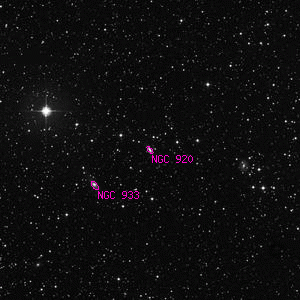NGC 920

Overlaid DSS image of NGC 920, 30' x 30' with north at top and west to the right
Aladin viewer for the region around NGC 920
IC 1799, MCG+08-05-012, UGC 1943, NPM1G +45.0061, PGC 9432
| Type | Galaxy |
|---|---|
| Magnitude | 13.7 |
| Size | 0.917' x 0.367' @ 35° |
| Right Ascension | 2h 28' 45.9" (2000) |
| Declination | 45° 58' 15" N |
| Constellation | Andromeda |
| Description | eF, eS, R, 1or2 eF* nr |
| Classification | S |
Observing Notes
Harold Corwin
NGC 920 = IC 1799. For decades, indeed for more than a century, most of us have accepted the galaxy that we now call UGC 1920 as NGC 920. It is, after all, only +16 seconds in RA, and +1.3 arcmin in Dec off Lewis Swift's position (02 20 10, +45 27 05), not all that far given Swift's usual statistical errors of 2-3 arcmin. The galaxy itself matches his description pretty well: "eF, eS, R; 1 or 2 eF * close; e diff." Swift found his object on 11 September 1885, the same night he found NGC 933 which is nearby to the east.
We might wonder about the nearby stars; there are three relatively bright ones forming a fine triangle just 2 1/2 arcmin southwest of the galaxy. We might have expected Swift to mention that triangle explicitly, but he doesn't. But that little detail never surfaced as few of us had looked closely at the field or at Swift's original paper.
Steve Gottlieb did both. His note early in January 2014 to Wolfgang and me reads in part:Swift's position for II-20 [the 20th object in his second list of nebulae, published in AN 2707] is also 70 tsec due west of IC 1799 = UGC 1943, and an excellent match in declination (given Swift's general accuracy). So, IC 1799 is only off in RA from Swift's position. His description mentions "1 or 2 eF* nr", which could apply to either galaxy, but UGC 1920 also has brighter nearby stars that to me would be mentioned [it was this that alerted me to the triangle of stars; I believe that these are the ones Steve mentions]. More importantly, though, IC 1799 is a more prominent galaxy than UGC 1920. In fact I probably would have missed UGC 1920 (the halo is very low surface brightness) in my 18-inch if I wasn't looking in the right place. IC 1799, on the other hand, was immediately noticed in the field, and has a much higher surface brightness. So, I'm suggesting NGC 920 = IC 1799 = UGC 1943.Wolfgang wrote back that his copy of Swift's paper came from Max Wolf's library in Heidelberg, and has "The '0' (of 20) is struck through and a '1' is noted to the right of the digit." So, Wolf, too, suspected a 1 minute error in Swift's RA (02 20 10 for 1885, as published). This leads to a difference in RA of only -10 seconds in RA and just -7 arcseconds in Dec -- negligible, in the face of Swift's usual errors.
Steve's only remaining question is why did Swift not call his 20th and 21st objects in his second list -- NGC 933 is the 21st -- a pair? Specifically, he often says of galaxies oriented like this "np of 2" and "sf of 2", but does not in this case. Instead, he says, interestingly, of both galaxies, "Powers 132, 200, and 265". Mention of different magnifications is a very rare comment for him. The fact that he appends it to the descriptions for both objects does connect them, at least vicariously.
Given all of this, especially the easier visibility of IC 1799, we have decided to accept Steve's (and Wolf's!) idea that Swift's object is actually the same one that Bigourdan came across five years later in January of 1891.
Other Data Sources for NGC 920
Nearby objects for NGC 920
Credits...
Drawings, descriptions, and CCD photos are copyright Andrew Cooper unless otherwise noted, no usage without permission.
A complete list of credits and sources can be found on the about page
NGC 920